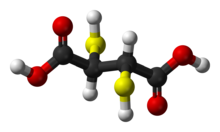Succimer
 | |
 | |
| Clinical data | |
|---|---|
| Pronunciation | /ˈsʌksɪmər/ |
| Trade names | Chemet, others |
| Other names | Dimercaptosuccinic acid DMSA (2R,3S)-2,3-Dimercaptosuccinic acid meso-2,3-Dimercaptosuccinic acid APRD01236 |
| AHFS/Drugs.com | Monograph |
| License data | |
| ATC code | |
| Legal status | |
| Legal status | |
| Identifiers | |
| |
JSmol) | |
| Melting point | 125 °C (257 °F) |
| |
| |
Succimer, sold under the brand name Chemet among others, is a
Common side effects include vomiting, diarrhea, rash, and
Succimer has been used medically since the 1950s.
Medical uses
Succimer is indicated for the treatment of lead poisoning in children with blood level measured above 45 µg/dl. The use of dimercaptosuccinic acid is not approved for prevention of lead poisoning in anticipation of exposure in known lead-contaminated environments. Dimercaptosuccinic acid can cross the blood–brain barrier of mice,[11] but it is not known if this is also the case in humans.[12] Even if dimercaptosuccinic acid cannot reverse the damages done to the central nervous system, it might prevent further deterioration.[13]
Succimer facilitates urinary excretion of lead, and with sufficiently aggressive treatment, can reduce lead content in the brain.[14] It also increases urinary excretion of copper and zinc.[15] Dimercaptosuccinic acid improved cognitive function in rats that had been exposed to lead, but reduced cognitive function in rats that had not been exposed to lead.[14]
Chemistry
Succimer is an isomer of 2,3-dimercaptosuccinic acid. 2,3-dimercaptosuccinic acid is the
The 2,3-dimercaptosuccinic acid molecule has two
 |
 |

|
 |
 |

|
| (2R,3R)-2,3-dimercaptosuccinic acid | (2R,3S)-2,3-dimercaptosuccinic acid (meso-2,3-dimercaptosuccinic acid) |
(2S,3S)-2,3-dimercaptosuccinic acid |
Preparation and reactivity
Dimercaptosuccinic acid[clarification needed] may be prepared by reacting acetylenedicarboxylic acid with sodium thiosulfate[16] or thioacetic acid followed by hydrolysis. The dimethyl ester is also known.[17]
Meso 2,3-dimercaptosuccinic acid binds to
History
Dimercaptosuccinic acid was first synthesized by
References
- ^ "Chemet- succimer capsule". DailyMed. U.S. National Library of Medicine. 12 December 2019. Retrieved 19 June 2022.
- ^ "Nephroscan- succimer injection, powder, lyophilized, for solution". DailyMed. U.S. National Library of Medicine. 1 March 2022. Retrieved 19 June 2022.
- ^ "Rotop - DMSA- kit for the preparation of technetium tc99m succimer injection injection, powder, lyophilized, for solution". DailyMed. U.S. National Library of Medicine. 9 March 2021. Retrieved 19 June 2022.
- ^ a b c d e f g "Succimer". The American Society of Health-System Pharmacists. Archived from the original on 16 January 2017. Retrieved 8 January 2017.
- ISBN 9783540278450. Archivedfrom the original on 2017-01-13.
- ^ "Succimer (Chemet) Use During Pregnancy". www.drugs.com. Archived from the original on 16 January 2017. Retrieved 12 January 2017.
- PMID 9630737.
- ISBN 9780080527574. Archivedfrom the original on 2017-01-13.
- hdl:10665/325771. WHO/MVP/EMP/IAU/2019.06. License: CC BY-NC-SA 3.0 IGO.
- ISBN 9781284057560.
- PMID 7741240.
- PMID 18077077.
- PMID 14585942.
- ^ PMID 24113857.
- PMID 19700440.
- ^ US 4550193, Lindemann MK, Lukenbach ER, "Process for the preparation of 2,3-dimercaptosuccinic acid and its lower alkyl esters", issued 29 October 1985, assigned to Johnson & Johnson Baby Products
- .
- ^ Liang Y, Chu C, Tsen Y, Ting K (1957). "Studies on antibilharzial drugs. Vl. The antidotal effects of sodium dimercaptosuccinate and BAL-glucoside against tartar emetic". Acta Physiol. Sin. 21: 24–32.
- ^ "Search Orphan Drug Designations and Approvals". Searchable database for Orphan Designated and or Approved Products. FDA. 2013. Archived from the original on 6 November 2014. Retrieved 5 November 2014.
- ^ "Sanofi Buying An American Drug Concern". The New York Times. July 17, 1996. Archived from the original on 6 November 2014. Retrieved 5 November 2014.
Further reading
- Aposhian HV, Aposhian MM (1990). "meso-2,3-Dimercaptosuccinic acid: chemical, pharmacological and toxicological properties of an orally effective metal chelating agent". Annual Review of Pharmacology and Toxicology. 30 (1): 279–306. PMID 2160791.
